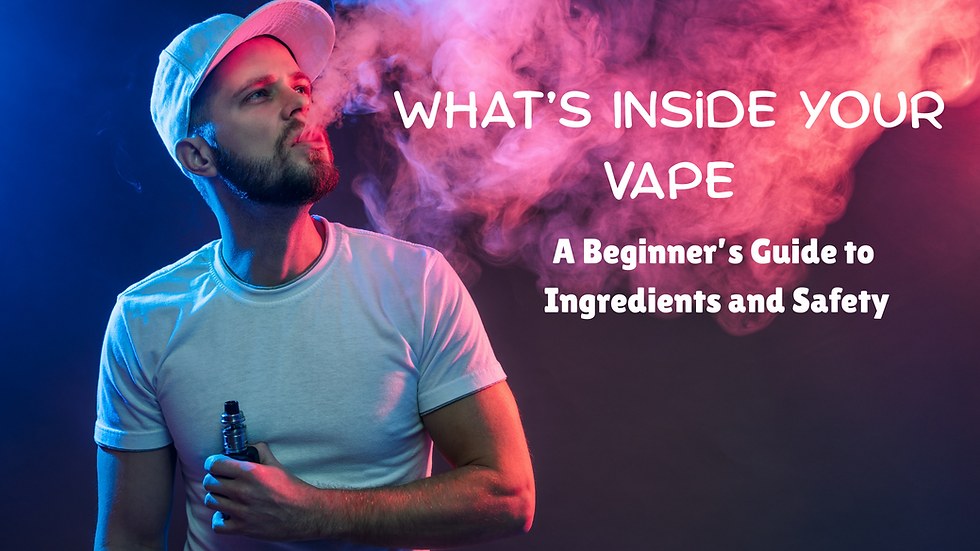What’s Inside Your Vape: A Beginner’s Guide to Ingredients and Safety
- CraveVape

- Aug 7
- 4 min read

If you're new to vaping or simply curious about what you're inhaling, understanding the ingredients in your vape is a crucial first step. This beginner’s guide covers what’s in vape juice, how vaping works, and what safety tips to follow, especially if you're buying vape juice in Canada.
Whether you're trying to quit smoking or exploring harm reduction options, this guide will help you make informed choices about the vape products you use.
What Is a Vape and How Does It Work?
A vape (short for vaporizer) is an electronic device that heats a liquid, known as e-liquid or vape juice, to create a vapor you inhale. Vapes don’t burn tobacco like cigarettes; instead, they produce vapor through a heating element called a coil.
Most vape kits include:
A battery (rechargeable or built-in)
A coil (the part that heats the liquid)
A tank or pod (holds the e-liquid)
A mouthpiece for inhaling
Once you activate the device (by pressing a button or just drawing air), the coil heats the vape juice and turns it into vapor. You inhale the vapor, which may contain nicotine, flavorings, and a combination of propylene glycol (PG) and vegetable glycerin (VG).
Main Ingredients in Vape Juice
The four core ingredients found in most vape juice include:
1. Propylene Glycol (PG)
Purpose: Carries flavor and creates a strong throat hit.
Other uses: Food additives, cosmetics, pharmaceuticals.
Safety: Considered safe by Health Canada and the FDA for ingestion. Inhalation research is still ongoing.
PG is ideal for those who prefer a sharp, cigarette-like sensation when inhaling. If you’re starting out, you may want to try vape juice with a 50/50 PG/VG ratio.
2. Vegetable Glycerin (VG)
Purpose: Produces thicker, smoother vapor clouds.
Other uses: Skincare products, sweeteners, and medicines.
Safety: Safe to ingest. Inhalation studies suggest it’s low-risk, but more research is needed.
High-VG vape juice is great for users who want smooth hits and dense clouds, especially in sub-ohm vaping.
3. Flavorings
Purpose: Adds taste, ranging from fruits and desserts to menthol and tobacco flavors.
Type: Food-grade, water-soluble flavor concentrates.
Safety: Most are safe to consume. However, some compounds (like diacetyl, once used in buttery flavors) can pose risks when inhaled. Reputable vape brands in Canada avoid these.
If you're shopping for flavored vape juice, check labels or websites for full ingredient transparency.
4. Nicotine (Optional)
Purpose: Delivers a familiar sensation and satisfies cravings for former smokers.
Forms:
Freebase Nicotine: Stronger throat hit, used in higher-power vapes.
Nicotine Salts: Smoother, ideal for pod systems or beginners.
Safety: Nicotine is addictive and stimulates the central nervous system. It’s safe when used responsibly by adults, but should be kept out of reach of children and pets.
In Canada, the maximum nicotine concentration is typically 20mg/mL, in compliance with Health Canada regulations.
What Are You Inhaling When You Vape?
You're not inhaling “water vapor.” Vaping produces an aerosol, a fine mist containing PG, VG, flavoring particles, and (if used) nicotine. Depending on your device and vaping habits, trace metals or thermal byproducts may also be present, especially if your coil is burnt or overheated.
This is why device maintenance and proper usage are key to safe vaping.
Vape Safety Tips for Beginners
To reduce risks and enjoy a better vaping experience, keep these tips in mind:
✅Buy From Reputable Retailers
Avoid unbranded or black-market vape juice. Stick with licensed vendors in Canada that list ingredients and follow Health Canada rules.
✅Start With Low Nicotine
If you're new to vaping, start with 3–6mg (freebase) or 20mg (nic salt). High doses can cause nausea, dizziness, or rapid heartbeat.
✅Read Labels Carefully
Check PG/VG ratios, expiration dates, and flavoring disclosures. Don’t trust mystery bottles with vague labeling.
✅Know Your Device
Use the right vape juice for your setup. For example:
Pod systems = Nic salts or 50/50 blends
Box mods = High-VG juices
✅Store Safely
Keep vape juice in a cool, dark place, away from kids and pets. Always use childproof caps.
Mixing the wrong combo can damage coils or ruin your experience.
Common Myths About Vape Ingredients
❌ Myth 1: “Vape juice contains antifreeze.”
Not true. The confusion comes from propylene glycol, which is also found in non-toxic antifreeze formulations. It’s also used in toothpaste and food products.
❌ Myth 2: “It’s just water vapor.”
Wrong. You’re inhaling aerosolized ingredients, PG, VG, flavoring, and nicotine, not steam or water.
❌ Myth 3: “All flavors are safe.”
While food-grade flavorings are safe to eat, some may pose risks when inhaled, especially those containing compounds like diacetyl (which is now avoided mainly by responsible brands).
How to Choose the Right Vape Juice in Canada
When buying vape juice in Canada, especially online, ask these questions:
Is it from a Health Canada–registered brand?
Are the ingredients and nicotine levels clearly labeled?
Does the company provide PG/VG ratios?
Are there customer reviews or lab test results?
At Crave Vapes, we prioritize ingredient transparency, fast shipping, and safe delivery across Canada, including discreet, same-day service in the GTA.
Final Thoughts: Vaping Safely Starts With Knowing What’s Inside
Vaping isn’t risk-free, but if you're switching from cigarettes, it's widely considered a less harmful option. By understanding what’s in your vape juice and how to use it properly, you take control of your health and your experience.
Always buy from trusted vape shops in Canada, read labels, and ask questions. The more informed you are, the safer and more satisfying your vaping journey will be.
Grab your vapes now at 10% off in the first week of August!





Comments